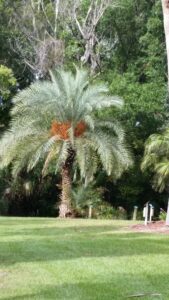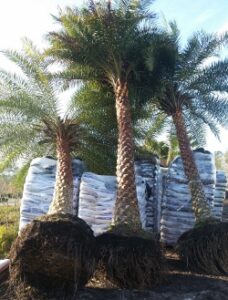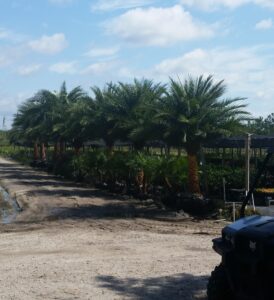Sylvestris Silver Date Palm / Wild Date Palm
( Phoenix sylvestris )
 Phoenix Sylvestris / Silver Date Palm / Wild Date Palm Origins:
Phoenix Sylvestris / Silver Date Palm / Wild Date Palm Origins:
– Phoenix sylvestris palms are native to India, Pakistan, Nepal, Bhutan, Burma and Bangaladesh. is well adapted to Florida growing and makes a perfect easy care and fast growing landscape specimen palm for the Northeast Florida Jacksonville and St. Augustine area landscape.
Phoenix Sylvestris / Silver Date Palm / Wild Date Palm Preferred Exposure:
– Full sun or partial sun and partial shade is preferable in the Northeast
Florida landscape.
Silver / Wild Date Palm Fronds | Trunk:
– Beautiful soft gray green to silvery green foliage of the Silver Date
palm make it strong focal point of the landscape.
– Fronds may reach 10 ft in length extending from the crown of the trunk up and outwards in its characteristic gracefully arching pattern.
– Sylvestris Date Palm remains evergreen through the winter in the North
Florida landscape and sustain no winter damage.
– Trunks of the Sylvestris Palm may eventually reach 25-40 ft
in height and 12-24 inches in diameter.
Silver Date Palm / Wild Date Palm Soil Preference / Salt tolerance:
– Sylvestris Date Palms planted in the Northeast Florida | Jacksonville | St.
Augustine landscape will tolerate virtually any soil components and grow well in dry sandy soils and moist garden soil alike.
– Salt tolerance is moderately high and Phoenix Sylvestris palms may be planted on the street side of ocean front properties
Sylvestris Date Palm Size Variance: 
– Phoenix Sylvestris palms can reach sizes of 20-40feet H | and
spreading 15-20 feet in width.
Growth Habit of the Phoenix Sylvestris Palm:
– Silver Date Palms grow up and out in a fountain of foliage with the
fronds bending and arching out and down as they mature.
Canary Island Date Palm Growth Rate:
– Faster growth rate than is typical for the Phoenix Palms, Sylvestris palms
can grow 1-3 feet in a years time. In full sun and irrigated spaces they will grow quickly and dry or sandy soil without additional irrigation will result in a slowed growth rate.
Blooms and Fruit:
– Long 2-3 ft flower stalks are a bright yellow color with tiny white blooms that will produce edible dates.
– Although this phoenix is not commercially produced as the edible
date, Sylvestris dates are smaller but excellent when fresh. Harvest the one inch long date fruits when dark red to purple in color.
– The Sylvestris palm is used in India as a commercial source of sugar and
often referred to as the sugar date palm. The sap is used to make sugar and used to make a fermented alchoholic
drink called a ‘Toddy’. The fruit is used to make jelly.
Water Requirements:
– Drought tolerant once established into the landscape. Take care to water well for the first few months after being planted from and S & J Nursery container into the landscape.
Best Uses For Sylvestris Date Palm in the North Florida | Jacksonville | St. Augustine landscape:
– Sylvestris Palms are the perfect fit for todays modern homes, easy care, pest free and the perfect size for a front yard accent.
Care of phoenix Sylvestris Palms / Silver Date Palms / Wild Date Palms:
– Date Palms will need good water during the establishment period and are
drought tolerant once established into the landscape.
– Trim back damaged or older browned out fronds each year as needed at the base of the stem to keep the plant at its best. Be sure to prune just past the last set of needle like thorns, removing those thorns when pruning older fronds helps keep the trunk size uniform on all sides and much safer to be
working around!
 MINIMUM PALM FERTILIZER REGIMEN – what you should be doing to keep your palm healthy
MINIMUM PALM FERTILIZER REGIMEN – what you should be doing to keep your palm healthy
– Fertilize each spring with a specially blended fertilizer for Palms, follow
manufacturers directions and apply 1/2 lb o 1lb of fertilizer per inch of diameter of trunk on your palm, measured from a hands width above the ground level. That means for a 12 inch wide trunk from left to right you
would need 6-12 lbs of fertilizer for just that one palm!
– Fertilize every fall with magnesium sulfate ( Epsom Salt) to keep your palm green and healthy through the winter months!
MAXIMUM PALM FERTILIZER REGIMEN – what you can do to get your palm up and growing Fast!
– Fertilize every three months with your choice of Palm fertilizer and
Magnesium Sulfate. Water 3-4 times per week and make sure to water thoroughly after each fertilizer application.
– Wait till fronds have turned completely brown before removing from the palm as the palm translocate nutrients from those older leaves and use it when forming new ones.
*CAUTION – DO NOT FERTILIZE NEWLY PLANTED
/ TRANSPLANTED
FIELD GROWN PALM TREES WITH PALM
FOOD!
Note : When planting smaller palms being grown in a container, this rule does not apply, rather, use half the recommended application rate for your trunks diameter, as containered palms roots have not been damaged or cut during planting but are still only a portion as large as they would be if the palm had been growing in the ground and excess fertilizer on a confined root system is still not preferable for maximum health.
Palm fertilizers are water soluble and will burn the new roots your palm tree is trying to put out as it establishes itself into the landscape. It is best to use only poly coated plant food that is heat release like Osmocote general purpose fertilizer or non burning Milorganite in the first year in the landcape, and then the following year, start your palm food regimen that will provide all of the minor nutrients that your palms will need to keep them healthy and problem free in Florida’s soils.

